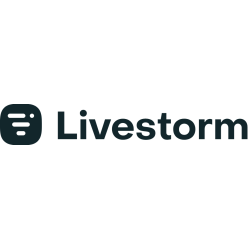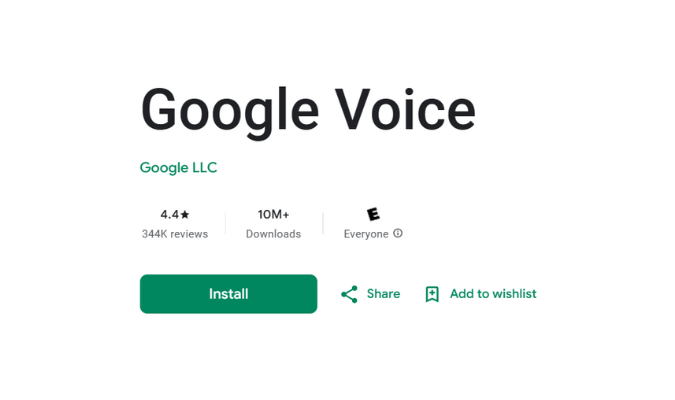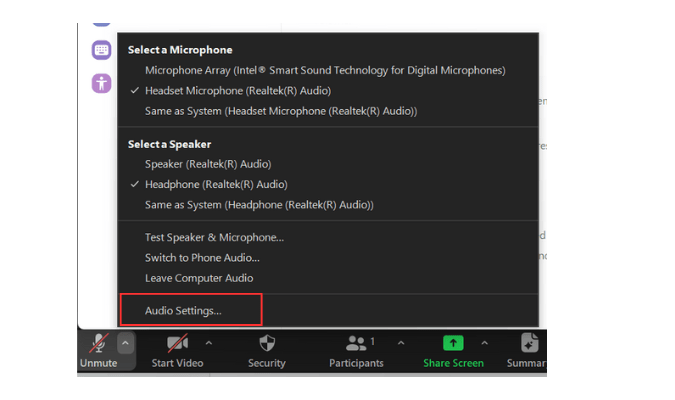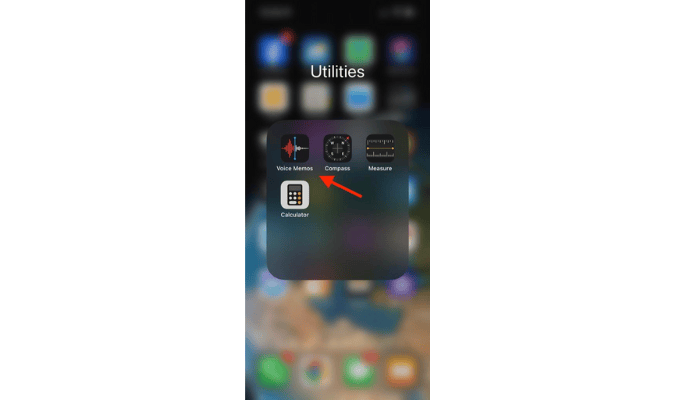Disclosure: This content is reader-supported, which means if you click on some of our links that we may earn a commission.
The best video conferencing software delivers everything you need to create a highly interactive face-to-face environment with built-in features that make digital collaboration easier than ever. As a remote team, we’ve tried countless video conferencing tools over the years and Nextiva is our top pick. You get unlimited video recording bundled with a complete live chat and VoIP calling system.
The Best Video Conferencing Software for Most
Nextiva
Best Video Conferencing Software For Most
Take your internal communication to the next level with video conferencing from Nextiva. Get screen sharing, secure file sharing, and unlimited video recording bundled with a complete live chat and VoIP calling system.
Nextiva is an industry leader in the communications category. And it’s our top pick for good reason. With it, you can enjoy high-definition video and audio calls, intuitive scheduling, and a user-friendly interface, making it a hassle-free platform for seamless communication
During video conferences, participants have the capability to share screens, securely exchange files within the call, and collaborate on tasks or entire projects. Post-meeting discussions are equally convenient, with teams utilizing Nextiva’s internal live chat or engaging in one-on-one calls for extended conversations.
The 6 Best Video Conferencing Options to Consider:
- Nextiva — Best video conferencing software for most
- RingCentral – Best free video conferencing option
- Zoho Meeting – Best for simple webinars at a budget-friendly price
- Microsoft Teams – Best video conferencing tool for large businesses
- Vectera – Best for branded 1:1 video calls with customers & clients
- Livestorm – Best if you focus heavily on webinars and live events
When It Makes Sense to Invest Into Video Conferencing Software
Most of us have used video conferencing software in some capacity to stay in touch with coworkers, friends, and family.
For personal use, any ol’ conferencing tool will do. But it pays to be more selective for business use since video conferencing software comes in all shapes and sizes beyond hosting virtual happy hours with beach-themed backgrounds.
There are free options, premium solutions, tools for hosting webinars or live events, simple solutions for smaller teams, fully customizable options, and everything in between.
Whether you’re facilitating large meetings with thousands of participants, meeting with a client, connecting with your audience, or bridging the gap between remote employees, video conferencing software is crucial.
It lets you connect with your people face-to-face—coworkers, customers, clients, friends, or audience members—from anywhere in the world.
Most video conferencing tools offer a free plan, moderately-priced premium tiers, and custom enterprise plans depending on the size of your conferences and the features you need.
So, you may not even have to pay anything to “invest” in video conferencing software.
#1 – Nextiva — The Best Video Conferencing Software For Most
Nextiva
Best Video Conferencing Software For Most
Take your internal communication to the next level with video conferencing from Nextiva. Get screen sharing, secure file sharing, and unlimited video recording bundled with a complete live chat and VoIP calling system.
Nextiva offers a simple yet powerful solution for video conferencing. This platform delivers HD video and audio calling, simple scheduling, a user-friendly interface, and many other helpful features.
So much of Nextiva’s platform can enhance your team’s collaboration, whether it’s happening before, during, or after video conferences and meetings.
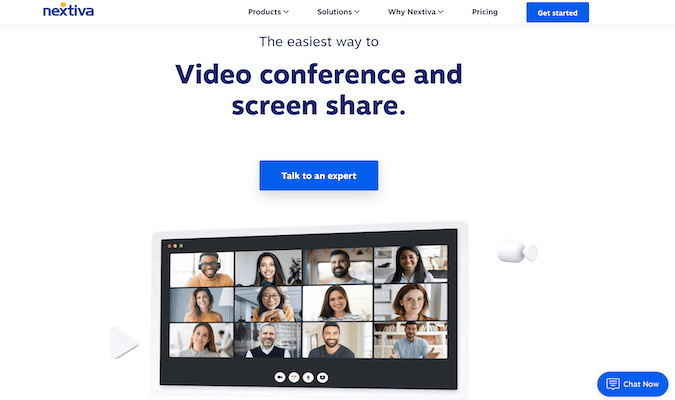
To begin with, setting up a meeting is super easy. Hosts can send invites and start meetings with just a couple of clicks in Nextiva, which also seamlessly integrates with Google and Outlook calendars.
During video conferences, attendees can share their screens, securely share files within the call, and work together on tasks or entire projects.
After calls, conversations can continue among smaller groups. Teams can collaborate via Nextiva’s internal live chat or hop on additional one-on-one calls if they need extra time to talk with a supervisor or another teammate.
You’ll also benefit from unlimited video conferencing recording capabilities. So, if someone misses a meeting or you want to refer to something from a previous call, you can always use these stored meetings as a point of reference. This also helps keep everyone engaged with the conversation happening on the call, since they won’t be forced to take meeting notes in real time.
It’s worth noting that video calls on Nextiva are limited to 45 minutes each. That shouldn’t be a problem for most meetings. And, while not always ideal, you could always cut one meeting short and then immediately start another one to work around this limitation.
Video conferencing comes on all of Nextiva’s business communication plans. There are three tiers to choose from. The following price points are applicable to teams of 20 to 99 people, when paid annually:
- Essential — Starts at $18.95 per user per month
- Professional — Starts at $22.95 per user per month
- Enterprise — Starts at $32.95 per user per month
The exact pricing of each plan is calculated based on your team size and contract length—with month-to-month and annual billing options available. Fewer team members or opting for monthly billing over annual payments will raise the per-month rate.
Start today by booking a free demo of Nextiva’s video conferencing solution.
#2 – RingCentral Video — The Best Free Video Conferencing Option
RingCentral Video
Best Free Video Conferencing Option
Host or join video conferences from anywhere using your web browser or the RingCentral mobile app in just a few clicks or taps. Enterprise-grade security, HD quality, dozens of integrations, an intuitive interface, and up to 100 participants make it one of the best FREE options on the market today.
RingCentral is an all-in-one business communications platform that offers VoIP phone services, internal messaging, faxing, business SMS, video conferencing, and more.
It also offers a standalone video conferencing tool called RingCentral Video. It’s perfect for anyone interested in a comprehensive—and free—virtual meeting solution. Allowing up to 100 participants and a 24-hour meeting duration, it’s the most robust free plan out of all the options on our list.
Other free versions limit you to 40 minutes or an hour for group calls, which can feel very limiting if you and your team rely on video conferencing as your sole method of face-to-face collaboration.
RingCentral Videos free plan is incredibly generous and a perfect starting point for most.
Like most basic tools, participants can join video meetings in one click from desktop or mobile devices without having to download anything. Users can also switch between devices with one tap at any time during calls, which is a handy feature for teams on the go.

If you schedule meetings in advance, RingCentral Video comes with two-way sync for Microsoft and Google calendars, too.
It makes scheduling easier than ever. You can preview your team’s calendars to find an open slot that works for everyone without the dreaded back-and-forth email exchanges that never fail to go on forever.
As the meeting host, you can lock the meeting and bar others from joining, control who’s allowed in from the waiting room, and easily mute everyone or individual users as required. With attendees joining calls from coffee shops, their home office, or their back patio, this feature is really handy.
The free plan comes with HD video and voice, so you never have to worry about poor call quality getting in the way of an otherwise productive meeting.
Each person with a free account gets 10 hours of encrypted recording storage space with a retention limit of seven days. However, you can download and save recordings elsewhere for as long as you’d like as long as you save it within that time frame.
Besides video conferencing, you can also use RingCentral Video for 1:1 or group instant messaging, chatting with external users, file sharing, and basic task management.
Another feature we love is the ability to turn attendee lists into chat rooms with one click.
In doing so, we can continue the conversation offline and keep all of our communications about a project in one place. It also works the other way, too. You can easily turn a chat room into an instant video meeting at the click of a button.
If you need to host larger meetings, you can upgrade to RingCentral Video Pro+. With it, you can invite up to 200 participants and you get 100 hours of secure video storage for 365 days.
The premium plan also comes with advanced meeting analytics, user management features, data retention controls, and priority 24/7 customer support that lets you jump the line.
Keep in mind that not everyone on your team needs a paid account—you can unlock RingCentral Video’s premium features with just one paid account, while everyone else stays on the free plan.
Just make sure that whoever has the paid account is the host for your large meetings.
If you also need a business phone system, you can upgrade to RingCentral Business Communications. It includes a complete VoIP setup, free phone numbers for your team, unlimited faxing and SMS, audio conferencing, and all the features from RingCentral Video.
It starts at $25 per month. It’s very expensive compared to video conferencing only, so we only recommend it if you need an all-in-one communications package.
To recap, RingCentral offers three paid options for video conferences, including:
- Video Pro – Completely free for up to 100 participants
- Video Pro+ – $11.99 per user per month for up to 200 participants
- RingCentral Business Communications Advanced Plan – Starts at $25 per user per month
For most, the free plan is more than enough to facilitate regular internal collaboration. However, Pro+ is smart if you host larger meetings or need more control.
RingCentral Office makes sense if you don’t have a business phone system and need one. Sign up for a free-forever account or a free trial to see if RingCentral is right for you and your team today!
#3 – Zoho Meeting — The Best for Simple Webinars at a Budget-Friendly Price
Zoho Meeting
Best For Simple Webinars
Need to host small, live webinars but don’t want to spend hundreds of dollars every month to do so? No problem! Zoho Meetings is a budget-friendly webinar solution that starts at just $19 per month for up to 25 attendees and all the features you need to deliver a seamless experience.
If you already use other Zoho products—like its CRM or Marketing Hub—or you need an affordable way to host webinars with fewer than 1,000 participants, Zoho Meetings is the way to go.
Whether you’re hosting webinars with a handful of attendees or even just a few hundred, Zoho Meetings is cost-effective and offers everything you need to offer an exceptional webinar experience.
Although it’s not as powerful as other webinar and virtual event solutions, it offers an excellent balance of functionality and affordability.
Whether you’re funneling leads into your sales funnel, training existing customers, or offering free educational content, you don’t need to spend hundreds of dollars a month on software.
And Zoho Meeting is one of the easiest live event and webinar solutions to use because of its focus on simplicity.
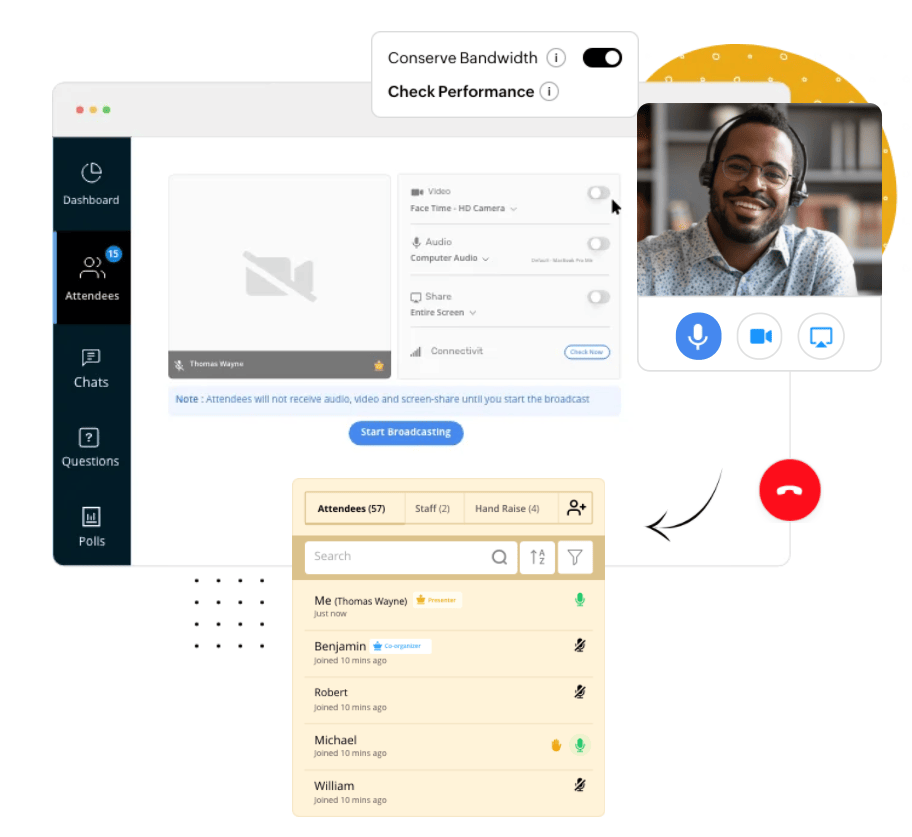
Regardless of how you plan to use it, the first step is creating a registration form so your audience can RSVP and get notifications about your upcoming event. With Zoho Meeting, you can customize these forms with your logo, company name, and colors to match your brand.
You can also include custom fields and questions to help you get a better understanding of who’s attending your event and how you can help them. Once your form is done, you can share the link or embed it directly on your website to start gathering signups and boost attendance.
Despite Zoho’s simplicity, you can also fully customize the content and design of your confirmations, reminders, and follow-up emails so every touchpoint aligns with your brand and messaging.
As registrants start to flow in, you can approve, deny, or cancel registrations to ensure only the right people attend your event. No spammers and no scammers allowed.
Once your webinar starts, participants can hop in with one click from any browser without having to download software. Attendees can also use a free dial-in number from 100+ countries to join by phone, instead.
If you want to gather valuable insight before or during your event, you can set up polls and view the real-time results as they come in. Not sure what topic to address first? Ask!
Want to know what specific thing people are struggling with most so you can meet them where they are? Create a poll and send it out.
As results roll in, you can even share your findings with attendees as well.
During events, users can message each other, ask questions, raise their hands, ask to speak, and share their screens if you let them.
Albeit simple, these features create an immersive and interactive experience for your guests.
However, no webinar is complete without a final call to action. When you’re done presenting, you can automatically redirect users to any URL—such as a thank you page, a survey, a custom landing page, or your website—and invite them to take the next steps.
All of Zoho Meeting’s paid plans come with storage space for up to 25 recordings. From there, you can download your recordings and offer them as a replay for registrants who couldn’t make it to your live presentation.
Overall, Zoho Meeting focuses heavily on webinar basics. It doesn’t come with marketing tools, advanced customizations, attendee acquisition features, or the ability to stream on social media.
But it comes with all of the essential tools you need at a much more affordable price than most webinar-specific tools.
There are seven pricing tiers to choose from, including:
- 10 attendees – free with limited features
- 25 attendees – $19 per host per month
- 50 attendees – $29 per host per month
- 100 attendees – $39 per host per month
- 250 attendees – $79 per host per month
- 500 attendees – $125 per host per month
- 1,000 attendees – $200 per host per month
In most cases, you only need one host account, unless you want to host multiple webinars at the same time. Compared to $99 per month for 100 attendees with Livestorm, Zoho Meeting is an absolute steal.
There are also affordable plans for virtual meetings if you prefer to have all of your video conferencing tools under one roof. There’s a limited free plan for up to 3 participants. Paid plans start at just $3 per host per month for meetings with up to 10 participants and go up to $12 per host per month for up to 100 participants.
Sign up for a free 14-day trial to take Zoho Meeting for a test drive today!
#4 – Microsoft Teams — The Best for Virtual Meetings with More than 200 Participants
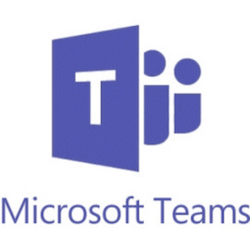
Microsoft Teams
Best for Large Meetings
Need to host meetings with more than 200 participants? No problem! Microsoft Teams offers various cost-effective plans that allow for meetings with up to 300 to 10,000 participants with 24-hour time limits, so you never have to worry about running out of space (or time) again.
If you need meeting space for more than 200 participants, RingCentral won’t work for you since it’s capped at 200 attendees. Microsoft Teams is an affordable and flexible alternative with the ability to accommodate up to 10,000 meeting participants.
Plus, at only $20 per month, the top tier is a steal—and less than twice the price of RingCentral. You unlock a lot of additional potential for not a lot more dollars.
It’s also a smart choice if you already use Microsoft 365 for business email accounts. If you do, you already have access to Microsoft Teams at no extra cost. You can start using it today with no software installs required.
If you’re not already using it and want to try it out, you can do so with Microsoft Teams’ free forever plan. It allows up to 100 participants with a 60-minute meeting duration limit. You can easily upgrade to a paid plan in a few clicks at any time if you enjoy the user interface.
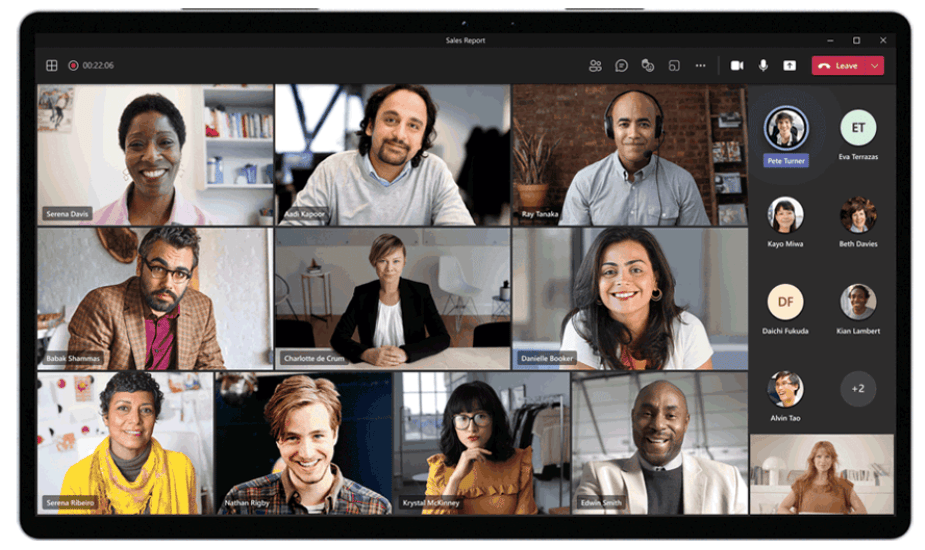
You can invite anyone with an email address to join you—participants don’t need an account to hop on a video call. So, it’s as easy as it gets for participants. If they can click a link, they can join you.
During meetings, users can share their screens, set virtual backgrounds, blur their backgrounds, and raise their hands to ensure your meetings are interactive and productive from the start. You can even start a virtual whiteboarding session to keep the creativity flowing.
You can also turn on live captioning, although we haven’t tested this feature to see how well it actually works.
Microsoft’s paid plans also include business emails for your team (if you don’t already have them), real-time file collaboration with Microsoft Office apps, and 1 TB of personal file storage plus 10 GB for every paid user.
You can use the storage space however you’d like, but keep in mind that it includes space for your meeting recordings, documents, and other files in one place. 1 TB of stored video can add up quickly if you’re not careful.
The Business Basic and Standard plans ($5 per user per month and $12.50 per user per month, respectively) let users host meetings with 300 participants and a 24-hour meeting duration.
The only difference between these two plans is that the Standard plan comes with desktop versions of all Microsoft Office apps—like Word, Excel, Outlook, PowerPoint—for all of your users and a built-in appointment scheduler.
However, they’re both a massive step up from the free plan, and more than enough for most businesses.
Regardless of the plan, users can set up an unlimited number of 1:1 meetings and group meetings, which encourages face-to-face collaboration. Even if your team’s distributed throughout the country or the world. With one click, anyone can hop on a call and get some facetime when they need to.
You can start a group or individual chats outside of video meetings to centralize documents, file sharing, and offline communications in one place.
If you need to host meetings with more than 300 participants, you’ll need to upgrade beyond the Basic and Standard plans to Office 365 E3.
In our opinion, it’s Microsoft Teams’ standout offering. You can hold meetings—conferences, even—with up to 10,000 participants at the same time.
With it, you get all the same features we already talked about, plus unlimited personal storage space for each user, and priority support. Meetings with up to 10,000 participants is already a steal, but adding unlimited storage space sweetens the deal tenfold.
Keep in mind that you can mix and match licenses. If you already have team emails, you can have everyone on a free plan with a few paid users who regularly host your large meetings.
This way, users can connect with each other at any time for up to 60 minutes while your power users can host large meetings with more advanced participant control.
Doing so helps keep your costs low while giving you all the virtual space you need.
To recap the four pricing plans to choose from:
- Free – up to 100 participants with 60-minute time limits
- Basic – $5/user per month for 300 participants with a 24-hour time limit
- Standard – $12.50/user per month for 300 participants with a 24-hour time limit
- Office 365 E3 – $20/user per month for up to 10,000 participants + priority support
Sign up for a free forever plan or a 30-day free trial to see if Microsoft Teams is right for you, your team, and your business today!
#5 – Vectera — The Best for Branded 1:1 Video Calls with Customers & Clients
Vectera
Best for Client Calls
Get everything you need to create unforgettable video experiences for your clients and customers to keep them coming back time and time again. Perfect for immersive consultations, product demos, collaborations, project reviews, and more with full customization capabilities and separate centralized hubs for every client.
Vectera is a bit different from the other options on our list. Rather than focusing on large calls with hundreds or thousands of participants, it’s specifically for 1:1 and small group calls with customers or clients.
Instead of a scalable platform, you get a fully customizable solution that lets you deliver white-glove experiences that keep customers coming back time and time again.
With Vectera, you get to control what the entire interaction looks like—your logo, custom colors, branded themes, and advanced JSS customization. You can even embed your meeting rooms on your website for highly personalized and custom experiences.
You can even choose personalized meeting room URLs.
Vectera comes with all of this—and more—without skimping out on essential video conferencing features, like HD video, real-time chat, screen sharing, and one-click recordings.
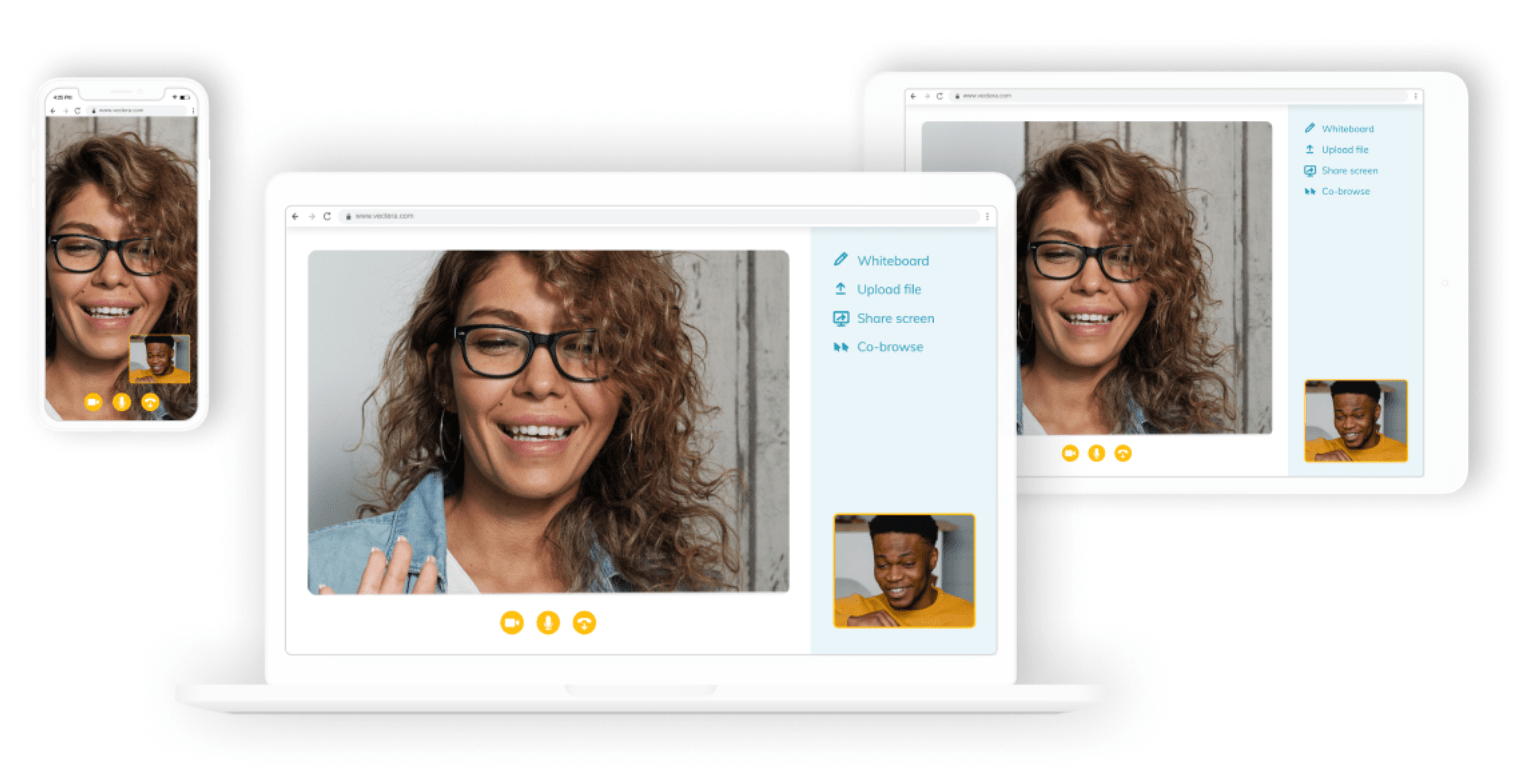
Clients and customers can hop on a call with you without downloading software—all they have to do is click a link and they’re in.
You can also configure custom waiting rooms if you want the added security to ensure unwanted guests don’t crash your call.
If you’re collaborating, brainstorming, or reviewing a project deliverable, you can upload documents and work on them together with real-time annotations, mark-ups and notes right on the document itself.
Plus, you can co-browse websites and documents at the same time to ensure your meetings are effective and productive.
Vectera’s customization even goes a step further. You get granular control over what features are available with which clients. Want to have a collaborative review meeting? Enable whiteboarding and co-browsing.
Want your next meeting to be more focused on presenting your deliverables? You can disable those options to simplify the interface and reduce distractions.
But what really makes Vectera a great option for client-based businesses is that each client gets a permanent and personalized meeting room.
It acts as a centralized hub for all of your conversations, recordings, documents, files, and chats. You and your client can both pull up previous documents, conversations, and notes to pick up right where you left off for a seamless transition from one call to the next—even if it’s weeks or months later.
Your account comes with a fully customizable built-in meeting scheduler so clients can see your availability and schedule meetings around your open time slots.
With the scheduler, you can set your availability as granular as you’d like, define buffers between meetings so you’re not stuck in back to back calls, and embed your scheduler on your website for public access.
You can even set up predefined appointment types, like a training session, a free pre-signup consultation, and a paid two-hour consultation to let your customers book whatever they need.
It supports just about every popular calendar app out there, so you can easily pull in existing appointments to ensure you’re never double-booked.
Want to charge for time on your calendar? With Vectera, it’s easier than ever. You can link your preferred payment methods to charge a deposit before they can schedule with you.
It supports most major payment options and even international currencies, too.
There are three pricing plans to choose from, including:
- Free – up to four clients with 1:1 video calls
- Pro – $9.99 per month for unlimited clients and calls with up to 4 participants
- Enterprise – custom pricing for full API access, SSO, and analytics
You can start with the free plan to try it out and see if it’s a good fit for you. Then, you can upgrade to the Pro plan for full customization options and unlimited clients.
Sign up for a free forever plan or a 14-day trial to see if Vectera’s right for you today!
#6 – Livestorm — The Best If You Focus Heavily On Webinars and Live Events
Livestorm
Best for High-End Webinars
Interested in hosting professional-grade webinars and live events? Livestorm offers everything you need to deliver personalized high-end experiences for live, automated, recurring, and on-demand webinars for up to 1,000 attendees with ease.
If you want to host professional-grade webinars or invite more than 250 attendees, Zoho Meeting isn’t going to cut it. Instead, we recommend Livestorm.
It’s about as high-end as you can get before having to jump into an advanced, pro-level software that comes with an enterprise-grade price tag and an impossible learning curve.
For those who don’t have time to master what the pros use, Livestorm is the perfect middle ground.
Whether you want to host live webinars, automated events as part of a sales funnel, or on-demand webinars your users can access any time, you get all the functionality you need.
It even includes basic options for small meetings—up to 12 participants—that you can use for sales calls, internal chats, or small customer training sessions to ensure a high-end experience at every touchpoint.
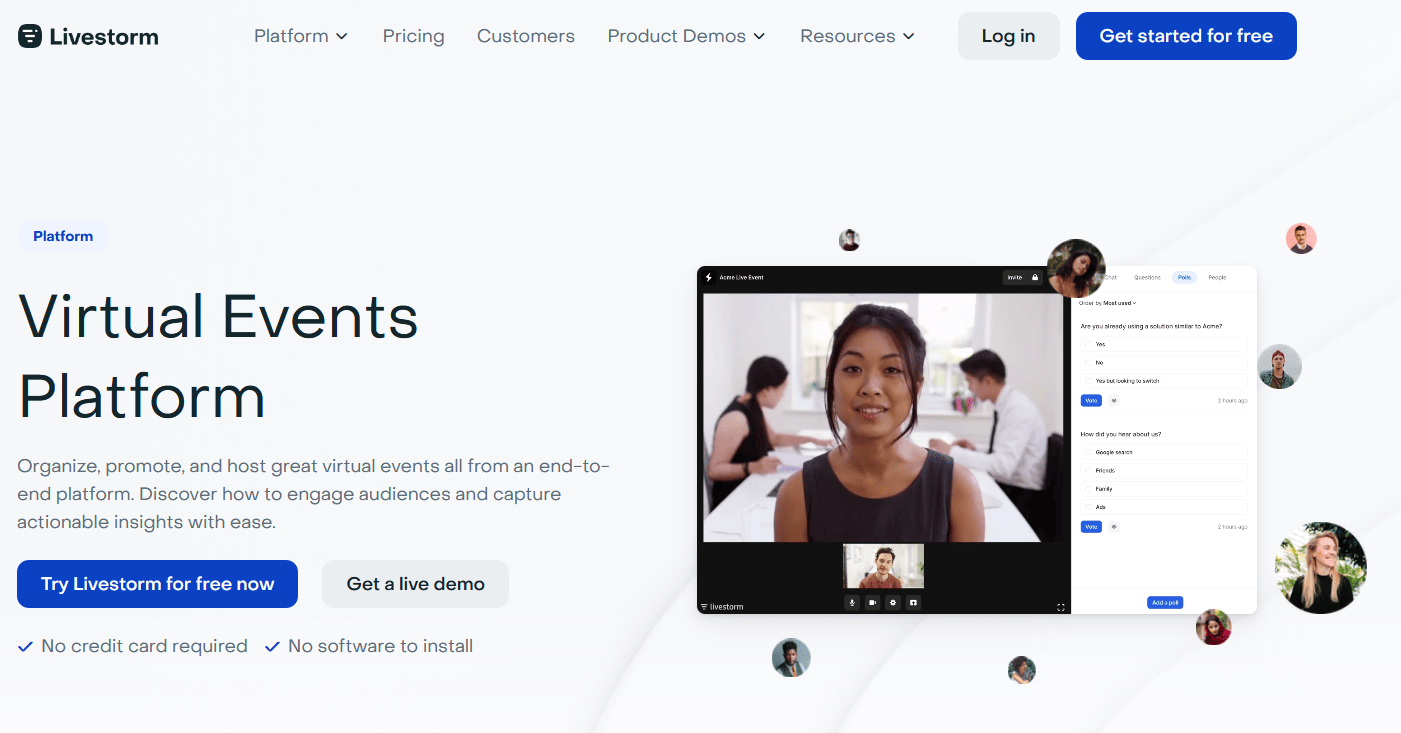
You can set up automations to run webinars on autopilot. To do so, all you have to do is schedule pre-recorded smartcasts, videos, and YouTube videos to play at specified times through your event without you having to lift a finger.
Your audience gets the benefit of a live webinar and you can focus on responding to questions or interacting 1:1 in the chat while the webinar runs its course.
To sweeten the deal, LIvestorm makes it easy to offer live events at multiple times throughout the day. This way, users can pick what time works best for them and all you have to do is link your automation to each event.
Prefer offering on-demand webinars your audience can watch at any time? No problem.
Livestorm gives you an unlimited amount of storage space, so you can record your event and store it forever.
Plus, all webinars and events are recorded automatically so you don’t have to remember to hit the button—and risk missing out on recording an entire event.
You can easily embed your recordings anywhere for easy 24/7/365 access.
Or you can display them on your pre-built custom company page and share the link with your audience. You can also display upcoming events and invite users to register for those as well.
If you want to charge for your events, it’s easy to set up through Livestorm’s Zapier integration. Once you configure your settings, the software does the rest for you.
Another standout feature is pre-built registration pages. They’re easy to customize with your logo, colors, and imagery, plus they’re well-designed and proven to convert. As such, you don’t have to embed your forms anywhere (unless you want to) or hire someone to design your registration pages for you.
In fact, you can customize the entire platform to match your brand for 100% white-glove events. Zoho requires co-branding, even on paid plans, so this is an excellent feature.
And you get complete control over the look, feel, and content of your automated emails. They use the Liquid template language, so you can easily add loops and logic for advanced email personalizations that aren’t possible with other video conferencing tools.
Livestorm also integrates with more than 1,000 different business tools and is GDPR compliant.
Overall, you get a lot of value-added functionality for your buck—as you should since Livestorm is significantly more expensive than the other options on our list.
There are five pricing plans to choose from, including:
- Free – up to 10 attendees per webinar and a 20-minute time limit
- Premium 100 – $99/host per month for 100 attendees
- Premium 250 – $198/host per month for 250 attendees
- Premium 1,000 – $328/host per month for 1,000 attendees
- Enterprise – custom pricing for plans with more than five hosts
You can add more hosts to any account for an additional $99 per host per month. However, you can have as many moderators as you want for free, so you probably only need multiple hosts if you plan to run concurrent webinars.
Sign up for the free forever plan to host a test webinar and see if Livestorm’s right for you and your business today!
Methodology For Choosing The Best Video Conferencing Software
When choosing our top picks, we looked at three main factors: intended use cases, participant limits, and user interface. Below, we break down the methodology we used into a step-by-step process you can use to identify the best choice for your business.
Are You Hosting Meetings, Webinars, or Both?
How you plan to use your video conferencing software plays a significant role in which one is best for you and the features you should look for.
Some tools offer a simple virtual meeting room to collaborate with teammates, others are better at facilitating client or customer meetings, several focus heavily on streamlining webinars and live events, and a select few attempt to do it all.
If you need an easy way to host virtual meetings, we recommend RingCentral for fewer than 200 participants and Microsoft Teams for more than 200.
Both come with all of the essential features you need to run and manage meetings, including screen sharing, recordings, whiteboarding, integrated chat, and basic administration controls.
Thankfully, most video conferencing tools for virtual meetings are pretty similar, straightforward, and easy to use. So, it doesn’t necessarily matter which one you choose as long as it supports the number of participants you have.
However, you need to be more selective if you want to deliver branded meeting experiences for clients and customers since most virtual meeting solutions aren’t customizable.
Going this route is a smart move for coaches, sales teams, customer service teams, professional service providers, healthcare institutions, software providers, client-based businesses, and anyone looking to add a layer of professionalism to their virtual meetings.
Rather than using any old meeting solution, the right software lets you provide a white-glove meeting experience that your clients, customers, and potential customers won’t forget.
When weighing your options, you should look for a brandable interface, advanced customizations with JSS, and a built-in appointment scheduler.
More advanced solutions may include a centralized place to store ongoing client and project communications, CRM integrations, payment gateway integrations, and open APIs for a fully customizable solution.
If client and customer calls are a big part of what you do, we recommend Vectera.
However, you should stick with RingCentral or Microsoft Teams if you only handle occasional client calls since those solutions are more recognizable and easier to use.
For webinars and live events, you’ll want to look for things like registration pages, customizable emails, paywalls for paid events, recording tools, automatic replays, CRM integrations, audience engagement tools, brandable rooms, and automations.
Many also come with limited instant video capabilities, although you may still need another solution if you regularly host virtual meetings with more than a few participants.
Because webinar solutions come with more features and advanced capabilities, they also come with a higher price tag.
Whether you’re delivering a free webinar as part of a marketing campaign, offering VIP paid seats to a private event, trying to connect with thousands in the middle of a pandemic, or something in between, the expensive price point is well worth it.
Why? Because these tools come with advanced features to help automate and streamline the experience for everyone—including you and your audience.
If your webinars are small and you don’t need anything fancy, Zoho Meetings is an excellent cost-effective option for live events with up to 250 participants.
Need more room, advanced customization options, or want to automate your webinars? Livestorm is the way to go. It’s more expensive, but it’s a more comprehensive tool for delivering live and automated high-end webinar experiences.
Participant Limits that Won’t Stunt Your Growth
Most providers offer a limited free plan and various tiers that depend on the number of participants you need.
However, most of them also have a maximum number of participants on the top tier. Once you hit those limits, you’ll need to move elsewhere unless you can opt for a custom plan. So, it’s essential to choose a provider you’re not going to outgrow in a few months.
If you have a small team or are just getting started, you can start with a free plan to try it out and make sure it’s the right fit for your team.
You may even be able to stay on the free plan for a while. But you should still make sure that there’s enough space for your business to keep growing.
For example, RingCentral Video’s paid plan allows up to 200 participants.
It’s great if you never get close to that limit, but it could be very restricting once you get close or go over since there aren’t any higher plans that allow more participants. Once you reach 200, you’ll need to switch to something else to accommodate those larger meetings.
However, RingCentral offers the best free plan with up to 100 participants and 24-hour meeting durations.
So, it’s a great place to start if you’re looking for something free.
With Microsoft Teams, the free plan is much more limited. But you won’t run into problems as you grow since you can scale up to meetings with 10,000 participants.
If you go with Vectera for brandable client calls, keep in mind that you can only host calls with up to four participants. The focus is primarily on small groups, so you won’t be able to use it for company-wide meetings or extensive collaboration sessions, even on the top tier.
For webinars, both Zoho Meeting and Livestorm offer limited free plans for up to 10 attendees. But Livestorm limits you to a 20-minute webinar duration.
Zoho’s top tier allows for up to 250 participants. But Livestorm allows for up to 1,000.
As such, Livestorm’s free plan isn’t as good—and its plans are more expensive—but you get a lot more room to scale as you grow. Plus, you get more advanced features to deliver professional-grade experiences.
Regardless of the option you choose, you can unlock higher meeting durations and participant limits even if only one person has an upgraded license.
For example, you could have all of your managers on RingCentral Video’s paid plan but keep everyone else on the free plan. In doing so, you allow your managers to host larger meetings while letting everyone else hop on 1:1 chats or small group calls at any time.
Or you could have one person on Microsoft Team’s top tier, a handful of managers on a middle tier, and assign everyone else to the free plan.
Keep in mind that you can scale your paid users up and down until you find the perfect balance.
With webinar and live event software, you probably don’t need more than one paid account unless you need to run several events simultaneously.
A Hassle-Free Interface that Doesn’t Get in the Way
If you’ve made it this far and are teetering between two or three options that all have the features you need, the best thing to do is sign up for a free trial.
After you sign up, you can set up test meetings and events to see how things work from both the host and participant point of view. Doing so gives you a first-hand look at the user interface, and you’ll usually be able to tell right away if you enjoy it—or hate it.
For the most part, your video conferencing software should easily be one of the most straightforward tools in your tech stack.
However, the most important thing is that it’s easy for participants to join. That’s particularly true if you’re inviting clients, potential customers, audience members, or non-tech savvy employees.
The best options require no software or downloads and offer a joining experience that’s as simple as clicking a link.
The last thing you need is someone missing out or getting frustrated because they can’t figure out how to join you. We highly recommend testing this out yourself. You should also try joining a meeting from your phone to test the mobile experience too.
Not only does this let you experience it first hand, but it also makes it easier to help others if there’s ever any confusion.
For admins and hosts, it should be straightforward as well. During your trial, pay close attention to how easy it is to set up. Starting meetings and events should be a virtually foolproof process.
During calls, hosts should have no problems sharing their screens or finding participant management features. Ideally, you can figure everything out in just a few minutes with little to no learning curve.
If it’s not that easy, consider choosing an option that’s more user-friendly.
With that said, highly customizable solutions and software for webinars or live events come with more advanced features, making them less intuitive on the backend than other options.
Regardless, the interface should still be user-friendly and easy to navigate for hosts and admins. So, it’s worth it to take the time to try them out and find an interface that works for you before making your final decision.
Nextiva
Best Video Conferencing Software For Most
Take your internal communication to the next level with video conferencing from Nextiva. Get screen sharing, secure file sharing, and unlimited video recording bundled with a complete live chat and VoIP calling system.
Summary
The best video conferencing software fits in your budget, is easy to use for everyone, and provides excellent call quality every time.
As such, Nextiva is our top recommendation for most users. Its features, ease of use, benefits, variety of use cases, and affordable pricing make it an ideal solution for most teams.
However, there are plenty of other viable options to consider.
So, don’t forget to use the recommendations and methodology explained in this guide to find the best video conferencing software for your unique needs and circumstances.





